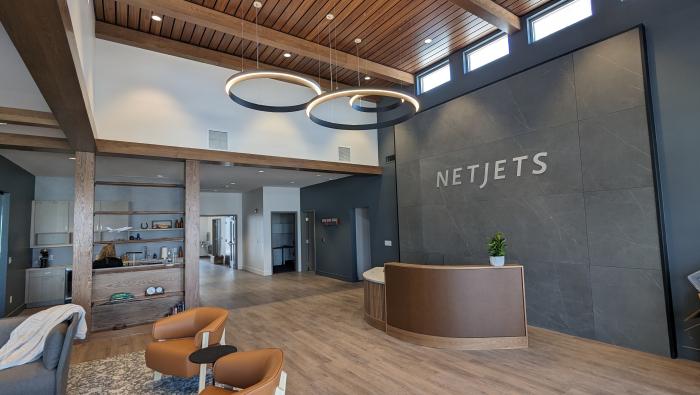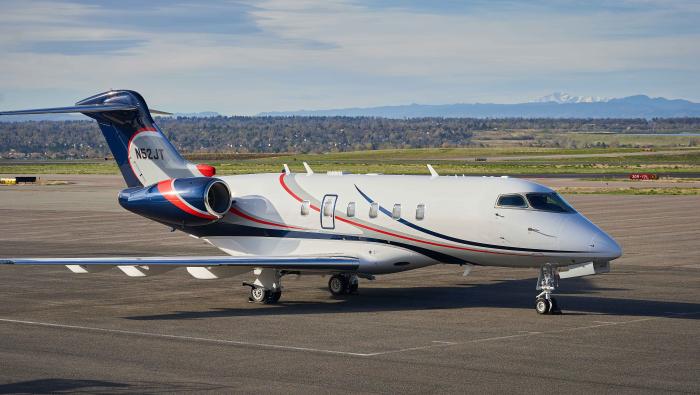|
NetJets, which controls the greatest market share of private aviation in the metro New York City area, will take over the former Signature Aviation South FBO terminal at Teterboro Airport (KTEB). NetJets had long occupied space in the terminal that will now be renovated in cooperation with Signature and entirely dedicated to serving the company’s fractional aircraft owners. The enhanced facility will include many of the amenities found in other NetJets exclusive-use terminals, including a private ramp and hangar space, owner lounge, conference rooms, refreshment bar, and dedicated parking starting in 2025. Signature recently increased its already sizable presence at KTEB with its purchase of Meridian, formerly the last independently-owned FBO on the field, giving it control of four of the six FBO locations there, and it will continue to operate Hangars 2 and 3 at the rebranded NetJets facility. Meanwhile, NetJets recently opened a dedicated terminal in Bozeman, Montana (KBZN). It will soon start work on an exclusive service hub in Scottsdale (KSDL)—its first new-build location, to be operated in partnership with Jet Aviation—and one in Las Vegas (KLAS), a two-hangar FBO with dedicated terminal and parking due to open in 2027. Other facilities are in various stages of development in Eagle, Colorado (KEGE); Atlanta (KPDK); Bedford, Massachusetts (KBED); and Austin (KAUS) and Dallas (KDAL) in Texas. |
|
|
The National Oceanic and Atmospheric Administration (NOAA) is exercising a $106 million contract option with Gulfstream Aerospace to purchase a preowned G550 modified by the OEM to support hurricane and tropical storm forecasts, atmospheric research, and other missions. Partially funded by the Inflation Reduction Act, the fully instrumented twinjet is expected to join NOAA's fleet in 2028. This will be NOAA’s second G550. The first was ordered from Gulfstream in 2019 and will replace the agency’s aging GIV-SP when delivered in the second quarter of next year. That GIV-SP has been part of NOAA’s hurricane hunter fleet since 1996. Both G550s will be fitted with a variety of sensors for collecting atmospheric data, including a tail-mounted Doppler radar system. “These new aircraft will greatly enhance NOAA’s ability to gather data critical to hurricane research and forecasting, atmospheric river research and forecasting, climate studies, and other missions,” said NOAA Administrator Rick Spinrad. The G550’s 51,000-foot service ceiling will allow the aircraft to paint a detailed picture of atmospheric conditions above and around hurricanes and tropical cyclones so NOAA can issue accurate forecasts. Data collected by the G550s will supplement low-altitude data collected by NOAA’s Lockheed WP-3D Orions, which fly directly into storms. According to the agency, the G550s will be based at the NOAA Aircraft Operations Center in Lakeland, Florida, alongside its other data-gathering aircraft. |
|
|
Engineering, flight test, and certification company AeroMech is developing a supplemental type certificate (STC) for the installation of SpaceX’s Starlink airborne connectivity system on the Textron Aviation Citation 560XL series. Applicable to the Excel, XLS, and XLS+ models, the STC will eventually be extended to include the new Citation Ascend, which will replace the XLS+ in Textron Aviation's lineup when it is certified in 2025. The Starlink installation includes an electronically steered antenna mounted on top of the fuselage and provides download speeds of up to 300 Mbps and uploads up to 35 Mbps. Everett, Washington-based AeroMech expects to receive the 560XL STC in September and plans to follow that up with STCs for the Citation Sovereign, X, Latitude, and Longitude; Cessna Caravan and SkyCourier; and Hawker 800/900-series jets. It also plans to certify two other airframes for Starlink installations by year-end and will make the STCs available to any Starlink dealer. Customers can have installations done by AeroMech’s AMI Aviation Services subsidiary, which includes a mobile team for remote installations. AeroMech’s first Starlink STC was for the Beechcraft King Air 200/300 series. |
|
|
The June 28 decision by the U.S. Supreme Court to overturn the Chevron doctrine providing legal deference to federal agencies likely will generate more court challenges and slow certain regulatory initiatives, a leading aviation attorney said. Matt Mentzer, a partner who leads the tax practice for the aviation law firm JetLaw, said he expects that courts will still weigh agency expertise in legal challenges. Even so, he added, the Supreme Court decision “has enormous implications for the aviation industry.” The FAA told AIN that it was unsure how it would affect regulations or any potential legal challenges, and industry associations are watching closely for potential ramifications. However, last week the House Transportation and Infrastructure Committee Republican leadership cited that Supreme Court opinion—the Loper Bright Enterprises v. Raimondo decision—in calling on the Department of Transportation and other agencies to provide a list of all relevant regulatory actions taken under the Biden Administration. “I do think that all federal agencies will pull back from issuing purely interpretative regulations unless Congress has delegated that authority,” Mentzer told AIN. “For items like airworthiness directives, I would expect a court to give broad deference to the FAA’s technical expertise and the FAA’s mandate to ensure aircraft are safe and uphold ADs. However, for those regulations that are interpretative, such as the Grand Canyon flight restrictions, I would expect more challenges across the board.” |
|
|
Sponsor Content: Gogo Business Aviation Gogo Business Aviation is bringing a new satellite-based inflight connectivity service, Gogo Galileo, to business aviation operators worldwide that will deliver a broadband experience with fast data rates and low latency to accommodate more devices onboard and data-hungry services like streaming video, video conferencing, cloud computing, and gaming. It is designed to fit on business aircraft of all sizes. |
|
|
Hawker 4000 operators have the option of installing a fully integrated Future Air Navigation System (FANS) and Protected Mode Controller Pilot Data Link Communication (PM-CPDLC) under a recent supplemental type certificate obtained by Textron Aviation. The Wichita aircraft manufacturer continues to support the super-midsize jet that has been out of production since 2013. Its FANS 1/A+ and PM-CPDLC program will enable pilots to ease communications with air traffic control and use the latest datalink services offered in North America and Europe. Textron Aviation highlighted several advantages of the upgrade, including the ability to quickly and accurately load complex instructions into the flight management system with the push of a button. The FANS 1/A+ and PM-CPDLC program further will support future datacom capabilities, trajectory-based operations, improved rerouting around severe weather and congestion, and prioritized departure clearances. Textron likened PM-CPDLC to SMS text messaging used on a cellphone but using prescribed messages to request and receive clearances. “The new cockpit technology upgrade for Hawker 4000 business jets reduces pilot workload and offers improved efficiency,” said Textron Aviation senior v-p of customer support Brian Rohloff. “Our team is committed to supporting customers throughout their ownership experience, and we made this option available through our global service network based on their feedback.” Textron Aviation can perform the upgrade at certain company-owned service centers in the U.S. |
|
|
A cross-section of aviation industry groups is urging congressional leaders to step up funding for air traffic control (ATC) maintenance and modernization at the FAA, saying in a letter that “the effects of underinvestment…are becoming strikingly clear.” Signed by 26 industry associations representing business and general aviation, airlines, air traffic controllers and specialists, pilots, flight attendants, and manufacturers—among others—the July 16 letter to leaders on the Appropriations Committees, in addition to Senate Commerce and House Transportation and Infrastructure Committees, said, “We also believe more must be done to not only maintain and sustain the ATC system but also to modernize it.” The groups asked the lawmakers to consider changes to the Airport and Airway Trust Fund (AATF) to enable the use of more funds for the FAA’s facilities and equipment account. While acknowledging the nation’s budgetary pressures, the groups also noted a growing uncommitted balance of the AATF—projected to reach $5.8 billion at the end of the current fiscal year and $9.5 billion by the end of the decade. “The AATF has the capacity to maintain and support additional investments that will help facilitate economic growth,” the groups said. Regarding underfunding, the groups expressed concern that necessary maintenance of existing systems is being neglected: “FAA switched to a ‘fix-on-fail’ model during the Fiscal Year 2013’s sequestration and has not returned to [one] of preventative maintenance.” |
|
|
Clay Lacy Aviation has completed its first five installations of SpaceX’s Starlink low-earth-orbit satcom terminals in Gulfstream and Bombardier ultra-long-range business jets. In March, the California-based aviation services provider announced that it had become a dealer for the airborne connectivity platform, which offers download speeds of up to 220 Mbps and upload speeds up to 25 Mbps on its global network. The Starlink constellation—with more than 4,700 satellites in orbit—can support video calls, streaming, online gaming, and virtual private networks. Among the first aircraft installations at the company’s MRO facilities at Van Nuys Airport (KVNY) and Waterbury–Oxford Airport (KOXC) in Connecticut were a trio of Gulfstream G550s, a G650ER, and a Bombardier Global 6000. Also supported among the STCs are installs on the Gulfstream G450 and GV, as well as the Bombardier Global 6500/7500, Express, and XRS. By the end of the year, the company expects to add the Bombardier Challenger 300/350/3500 and Global 5000; Gulfstream IV; Embraer Legacy 600/650, Praetor 500/600, and Phenom 300, among others. “There has been high demand for this transformative, connectivity technology,” explained Edward Diaz, Clay Lacy’s avionics operations and sales manager. “Our team is moving quickly to provide low-downtime, expertly completed installations so that owners and operators can get the most out of their aircraft.” |
|
|
Honeywell has selected Gama Aviation Engineering to join the OEM's aircraft engine service center network in Europe, the Middle East, and Africa. From its facility at Bournemouth in the UK, Gama will provide line maintenance for the TFE731 turbofan, as well as for Honeywell auxiliary power units on business jets. Under the agreement, operators using Gama's Bournemouth center can keep their engines in compliance with the requirements of Honeywell’s Maintenance Service Plan. Game holds EASA and UK Civil Aviation Authority maintenance approvals and specializes in supporting business aircraft. “Our collaboration with Gama Aviation Engineering strengthens our service network and ensures that operators have more access to authorized maintenance,” said Anthony Florian, Honeywell Aerospace Technologies’ president for Europe, the Middle East, Africa, and India. “This agreement underscores our commitment to providing reliable and efficient maintenance support for aircraft operators in the region.” UK-based Gama Aviation is also active in aircraft management and charter services. It operates FBOs in Glasgow, Scotland; Jersey in the Channel Islands; and Sharjah, UAE. |
|
|
|
|
|
|
AINalerts News Tips/Feedback: News tips may be sent anonymously, but feedback must include name and contact info (we will withhold name on request). We reserve the right to edit correspondence for length, clarity, and grammar. Send feedback or news tips to AINalerts editor Chad Trautvetter. |
|
AINalerts is a publication of AIN Media Group, 214 Franklin Avenue, Midland Park, New Jersey. Copyright 2023. All rights reserved. Reproduction in whole or in part without permission is strictly prohibited. |
















